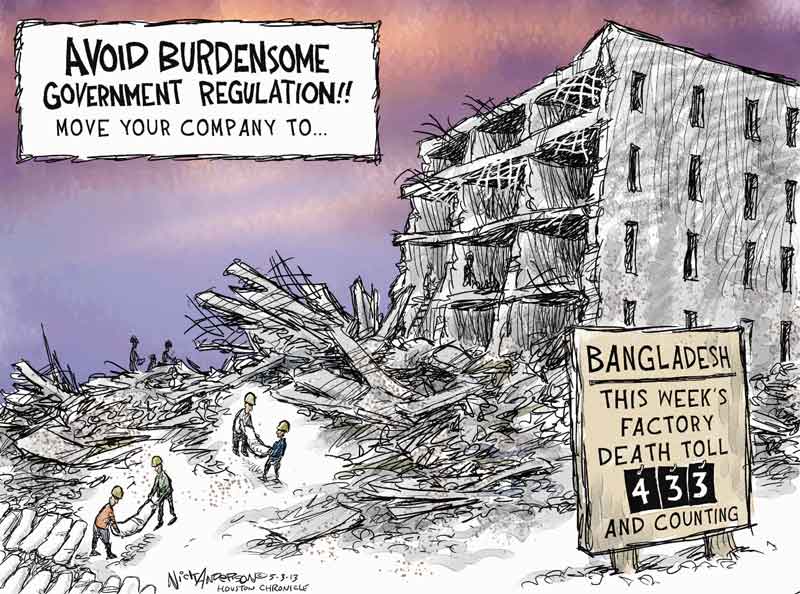When a fire at the Tazreen garment factory in Bangladesh killed 112 people in November, many wondered what more it would take before something would be done to improve labor conditions in the country, the world’s No. 2 clothing exporter.
The world didn’t have to wait long for the next test: the collapse on April 25 of Rana Plaza, an eight-story building housing multiple factories. At least 403 people have died.
In total, more than 1,000 garment workers have been killed in Bangladesh since 2005, according to the International Labor Rights Forum, an advocacy group.
Sewing clothes isn’t inherently dangerous. Deaths can be prevented if factories adhere to basic fire and structural standards. Can this happen in Bangladesh, where in 30 years the garment industry grew from nothing to an $18 billion a year business on the premise of cheap labor and minimal effective regulation? It’s an example of the kind of tough challenge that, increasingly, producers and consumers in a global marketplace must jointly meet.
Yes, it would be ideal if the government firmly enforced building codes and fire standards. But Bangladesh is one of the world’s poorest countries. Don’t expect it to have a first-rate enforcement regime. Moreover, owners of the small and medium factories that are typically the most unsafe can’t afford to make major improvements; to survive in the competitive world of outsourcers, they generally operate on slim profit margins.
So who’s left? At this point, Western retailers and consumers, who have the immediate wherewithal to effect change. First-world consumers have been the chief beneficiaries of the growth of garment manufacturing in Bangladesh and other developing countries.
Americans are reaping bargains by importing more than 97 percent of what they wear. Since 1998, women’s clothing costs have fallen 7 percent, and men’s have fallen 8 percent. In Britain, costs have dropped 20 percent since 2005.
Creating safe work conditions in Bangladesh wouldn’t put much of a dent in those savings. The Worker Rights Consortium, an independent labor rights monitoring group, estimates that it would cost $600,000 on average to elevate each of the country’s 5,000 factories to Western safety standards, for a total of $3 billion.
If the $3 billion were spread over five years, it would add less than 10 cents to the factory price of each of the 7 billion garments that Bangladesh sells each year to Western brands. If the factory owner passed on that cost to the retailer and the retailer passed it on to the consumer, with markups, this could mean, perhaps, a 25-cent increase for the final buyer per item.
These changes would hardly price Bangladesh out of the market. Its garment workers are guaranteed a minimum wage of only 18 cents per hour, less than half what the next cheapest competitors, in Cambodia, earn.
For global brand retailers, ensuring factories are safe is not only right but also smart. Remember the consumer backlash over conditions in Vietnamese factories that made Nike products? During the 1990s, that cost the company sales and share value.
Major retailers caught up in the Rana Plaza collapse include Associated British Food’s Primark and Loblaw Cos.’ Joe Fresh. Wal-Mart Stores was supplied by Tazreen. More catastrophes could expose these companies to harsh scrutiny. Certainly these tragedies are already provoking unusual labor unrest that is disrupting production and hurting the bottom line.
On the other hand, global brands that take steps to improve working conditions can potentially charge a premium for their wares: A 2009 study undertaken at a major retail store in New York suggested that companies could use “social labeling” to charge from 10 percent to 20 percent extra and still expect sales to rise.
Retailers can ensure factory improvements are made by signing on to the Fire and Building Safety Agreement for Bangladesh, a program promoted by workers’ rights advocates. The agreement would establish a chief inspector — independent of companies, trade unions and factories — to execute a safety program. Audits of hazards would be made public. Corrective actions recommended by the inspector would be mandatory.
Retailers would agree to pay factories enough so that they could afford renovations, and retailers would be forbidden from doing business with noncompliant facilities. These obligations would be enforceable through the courts in retailers’ home countries.
The inclusion of labor representatives on the task force overseeing the agreement would build employee confidence in factory safety. So would a clause establishing that workers make up at least half the members of factory health and safety committees.
So that the program will have sufficient leverage over factories, it is to go into effect only after four retailers have signed on. The German retailer Tchibo and PVH Corp. have agreed so far. PVH did so only after it came to light that its brand Tommy Hilfiger had resumed business with a Bangladesh factory where 29 people were killed in a fire.
For the retailers that have held back, signing now offers protection for Bangladesh’s workers and against such scandals.
Failing such reforms, the “Made in Bangladesh” label seems likely to turn into a scarlet letter.
Editorial by Bloomberg View
Send questions/comments to the editors.



Success. Please wait for the page to reload. If the page does not reload within 5 seconds, please refresh the page.
Enter your email and password to access comments.
Hi, to comment on stories you must . This profile is in addition to your subscription and website login.
Already have a commenting profile? .
Invalid username/password.
Please check your email to confirm and complete your registration.
Only subscribers are eligible to post comments. Please subscribe or login first for digital access. Here’s why.
Use the form below to reset your password. When you've submitted your account email, we will send an email with a reset code.